This post may contain affiliate links. Read our disclosure here.
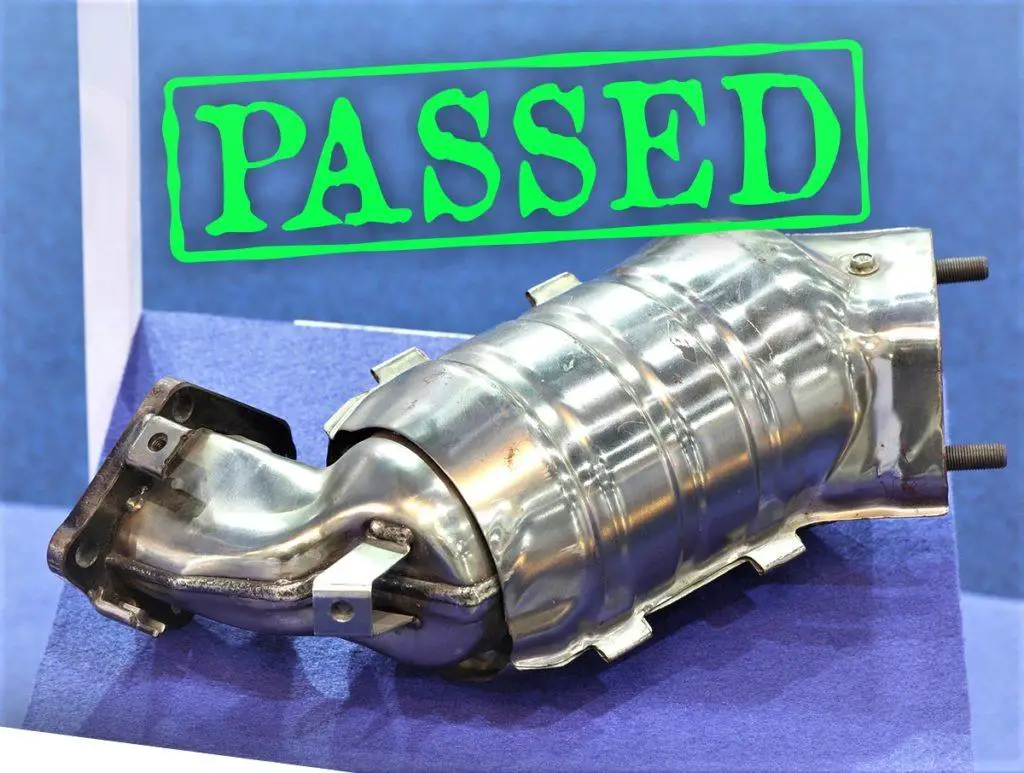
Welcome to our exhaustive guide on fixing issues with dirty and failing catalytic converters!
This article will focus on the technology and reasoning behind catalytic converters, and will explore the how and why they sometimes get clogged and even fail completely. We’ll also explore the latest additives available to buy, and use our expertise to show which additives are best to clean and restore any type of catalytic converter.
Join us as we dive into the science behind the additive products that can help with catalytic converter issues. We dig deep into these additives and how they can help you extend the life of your car by cleaning your converter, reducing emissions, and helping you to pass any inspections or tests that are required for your car to be road legal.
>Spoiler Alert: Click here to see the best additive for cleaning a converter<
What is a catalytic converter and why would it need to be cleaned?
A gasoline internal combustion engine emits harmful exhaust gases during normal operation. It is an unavoidable part of the combustion process, a byproduct of fuel and air being ignited. If this process were to go unaddressed it would release pollutants and toxic gases into the atmosphere.
Fortunately for the air that we all breathe, there is a way to remediate these harmful gases, by way of a special device called a catalytic converter.
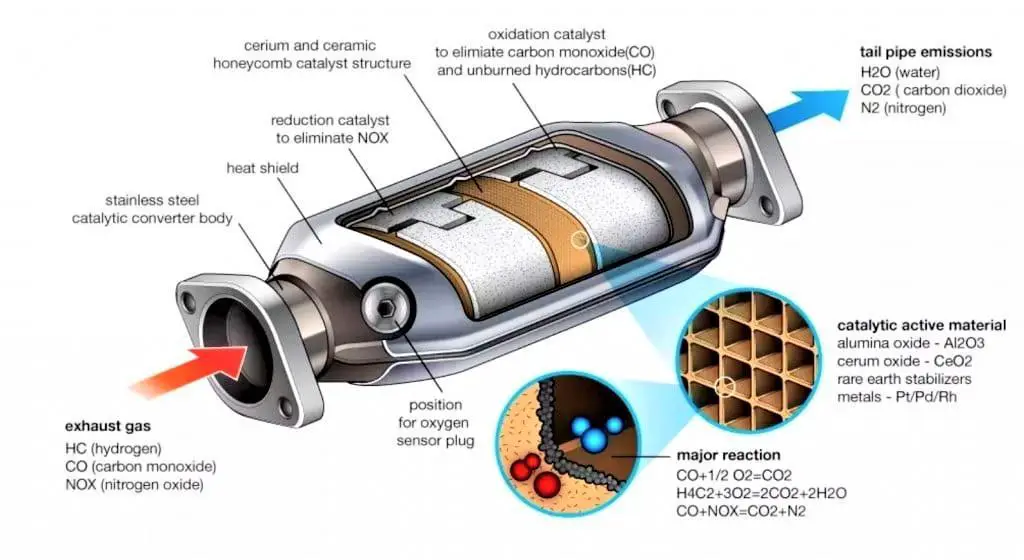
Catalytic converters are an emissions device located in your vehicle’s exhaust that converts the harmful emissions from your car’s engine into an environmentally friendly alternative. They use precious metals to cause a reaction, using oxidation and something called reduction to reduce emissions.
Sometimes however, catalytic converters can get clogged by a poor running engine or a worn out engine that allows oil past the piston rings or pcv system and into the exhaust, where it coats the converter and reduces its effectiveness.
Why do catalytic converters fail?
There are a couple different ways in which a converter can fail. Sometimes they are recoverable, and in other cases they fail spectacularly and require a replacement.
Misfiring and running excessively rich or lean
The main way in which they can fail is when your car is misfiring or running extremely rich or lean. The problem with a poor running engine is that it can superheat the converter, causing the internal structure to melt or otherwise be damaged.
This sometimes leads to the honeycomb structure inside the converter breaking apart. When that happens, the pieces can wedge themselves sideways within the body of the converter, causing a BIG issue with exhaust flow. This can become such a problem that it actually chokes the engine and because the air cannot exit through the exhaust, you end up with a car that is way down on power. This is considered a fully clogged converter and WILL heavily impact engine performance.
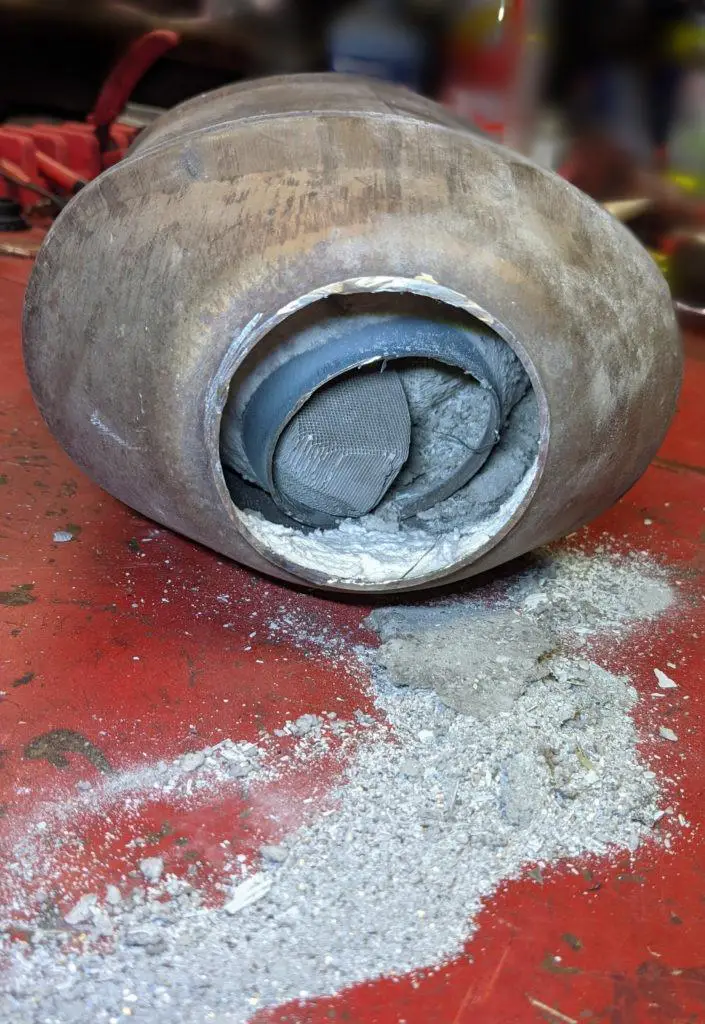
Because of this type of catastrophic failure, which ALWAYS requires expensive converter replacement, it is a much better idea to fix the issue with a poor running car and attempt to clean the converter, rather than to let it fail which could leave you stranded.
Oil damage
Another thing that causes catalytic converter failures is excessive oil consumption. The oil sits on the honeycomb inside the converter, causing the metals to be unable to cause the reaction that they were designed to. This can lead to a P0420 or P0430 code, for poor converter efficiency. If you have a check engine light and need to see if you have this code, check out this very inexpensive universal OBD code reader here. This scanner also has a function to perform a virtual smog check, so that you can know exactly what needs to be addressed before a trip to your local emissions testing center.

The first and best thing to do in this situation is to start by checking that your Positive Crankcase Ventilation (PCV) system is working correctly. Otherwise, the excessive oil consumption could be caused by poorly sealing piston rings, or a turbo with leaking seals.
Fortunately this is not a catastrophic failure, and can be remedied by cleaning the converter in some cases. Keep in mind that if the source of the excessive oil consumption is not fixed, the issue will likely happen again.
How to clean a catalytic converter
If your car is having these issues and symptoms, the first thing that you can try is to buy an additive that is designed to clean your catalytic converter. There are a ton of options that you can try, however we wanted to break down the best ones that are most likely to work, according to the science and ingredients that make them tick.
For that reason, we have thoroughly examined the top 3 catalytic converter cleaners that are available, at least as of the writing of this article in 2021.
1. Cataclean Fuel and Exhaust System Cleaner
As far as we know, Cataclean is the only patented catalytic converter cleaner on the market. This means to us that the formula has been refined to the point that they felt the need to protect it by any means necessary.
Born from a racing heritage in the UK, the people behind Cataclean have been experimenting with fuel additives since 1995. They realized back at the beginning of development that there is quite the need for a product to help their customers pass MOT, which is the Euro version of our emissions tests in the US.
The success of the Cataclean product in the UK led them to seek a partner for worldwide distribution, resulting in them joining Holley USA to bring their product to our stores. They have received a stamp of approval from the EPA, meaning that their formula meets low VOC (Volatile Organic Compound) requirements and is fully approved for use in US vehicles.
How does cataclean work?
This innovative catalytic converter cleaner works by using a chemical process to carry a special blend of solvents throughout your entire fuel system and combustion process, making its way throughout your entire engine, with the end goal of attacking the junk built up in your fuel system, combustion chamber, and catalytic converter.
The beauty of Cataclean is that on it’s way to cleaning your converter, it also dissolves gunk buildup in your injectors and helps to break down carbon deposits on your valves and combustion chamber.
This leads to an overall smoother running engine, helping to reduce emissions and working towards eliminating any P0420 or P0430 emissions codes that you may have.
What ingredients are in Cataclean?
To get an idea of the active ingredients and deduce how Cataclean works the way that it does, we can simply take a look at the patent US20140000158A1.
If you look at the section with the patent claims, it gives the official scientific reasoning behind the formula and all of the possible ingredients and how they are related.
To break it down simply into terms that even a non-scientist understand, the Cataclean formula contains a few main ingredients:
- Acetone (Solvent)
- Xylene (Octane Booster)
- Isopropanol (Isopropyl Alcohol)
- Long-Chain Hydrocarbons (Mainly Paraffin)
These main ingredients combine powers to produce oxygen inside your engine in order to break down the layers of carbon deposits inside the combustion chamber and on the catalytic surface. They also form a carboxylic acid vapor which works to break down and clean deposits on the honeycomb structure of the catalytic converter.
The science behind how these ingredients actually work has been extensively studied and subsequently proven to strip away inorganic contamination in a way that does not affect the fueling or efficiency of your engine.
Cataclean Usage and Dosing Information
Being that the Cataclean formula was designed in the UK, on the original bottles they use milliliters and liters in the instructions on how much to add. Not to worry, we’ve made a handy conversion to American!
For 15 liters of fuel, you’d need to add 450ML of Cataclean to your tank.
For imperial, that converts to using 15.2oz for every 4 gallons of gasoline.
In most applications, that simply translates to adding the entire bottle to your tank once it is down to about ¼ tank or so.
The instructions say to add the entire bottle to your quarter tank of fuel, and then drive around for 15 miles or so. It’s important to keep the engine RPM’s high during this step, as the harder the engine works, the better chance the additive has to clean everything. After the driving step you’ll want to fill your tank to full, I would recommend using premium fuel at this step just for the added octane boost.
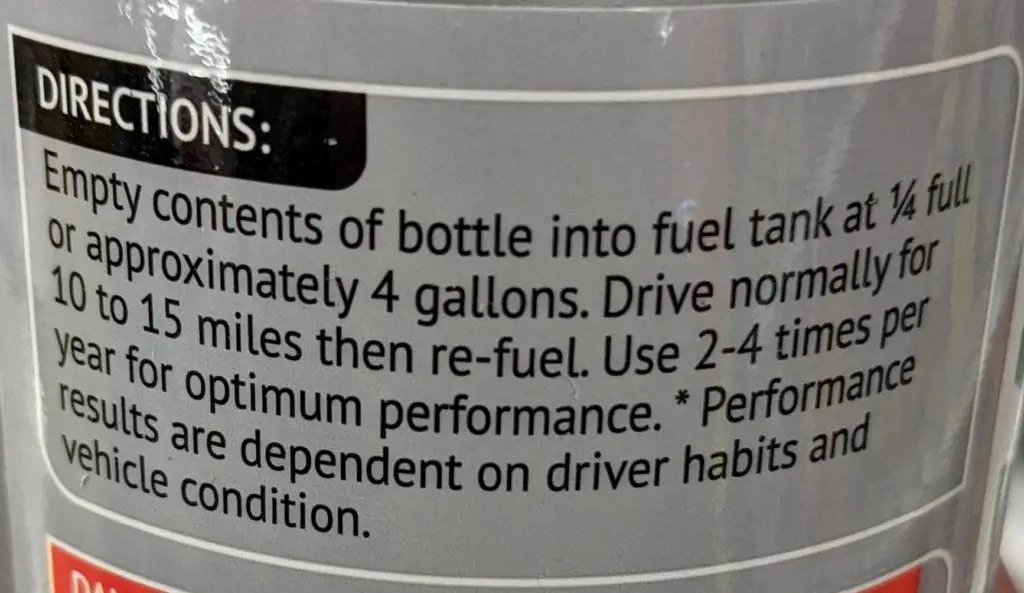
Cataclean Real World Reviews
Reading the customer reviews of this product will show you that about 65% of the time that people are adding Cataclean, it works for them to address their concerns of check engine lights, namely P0420 and P0430.
Considering that no catalytic cleaner additive can fix a mechanical issue with a poor running engine or a physically damaged catalytic converter, these odds are pretty good.
A large percentage of the users report that Cataclean was the only way that they could even pass their required emissions tests, tests that they had previously failed.
2. CRC Guaranteed to Pass Emissions Test Formula
This additive by CRC is a solid second place choice for a couple of reasons, the main one being quite obvious in the actual name of the product. Guaranteed to pass is just that, they guarantee that you can use their product to pass your emissions test, or you can file a claim to get DOUBLE your money back.
Now, there are some caveats to this guarantee of course, CRC does not offer money back for cars that have actual mechanical issues, like a failed/clogged converter or broken injectors/ignition systems that cause misfiring.
If you’re familiar at all with automotive companies, CRC will not be a new name for you. They produce a HUGE range of automotive related chemicals and additives. Just take a look on the shelves of your local auto parts store, they almost always have a big lineup of CRC products. All this to say, I trust CRC and have used many of their products in my automotive repair career.
How Does Guaranteed to Pass Work?
This additive works by using powerful detergents and solvents to dissolve and banish varnish and carbon deposits from your fuel system, combustion chamber, valves, and catalytic converter.
The cleaning action provided by this additive helps your car to run cleaner and more efficiently, reducing emissions and helping you pass your inspection for another year.
What ingredients are in Guaranteed to Pass?
Guaranteed to pass contains 6 main ingredients, including their secret formula.
The active ingredients are :
- Diesel Fuel no.2
- Secret Formula
- Petroleum Distillates
- Naptha Petroleum Solvent
- Napthalene
- Benzene
These ingredients, when mixed in the way that only CRC knows the secret to, have a profound effect on the fuel system and combustion efficiency of your engine. The detergents in Guaranteed to Pass are designed to clean and remove varnish and carbon deposits all throughout your engine and exhaust.
This cleaning effect helps your engine to run more efficiently, helping your car to pass any emissions tests that you are subject to in your state or country.
Guaranteed to Pass Usage and Directions
CRC has three simple steps to using their product.
- Starting with a full tank of gasoline, add the entire 12oz bottle. Use two bottles if your tank holds over 16 gallons.
- Drive your car until the tank is empty, this will ensure that the entire product has mixed with your gas and been burned through the engine.
- Refill your tank before you take your car in for emissions testing.
According to their directions, this means that 12oz of Guaranteed to Pass treats up to 16 gallons of gasoline.

Guaranteed to Pass Real World Reviews
If we take a peek at the most popular reviews for Guaranteed to Pass, we can see a recurring theme of people having issues with passing their emissions tests, and subsequently trying this additive or multiple additives in order to try and get their car to pass.
Just like Cataclean, Guaranteed to Pass seems to have a success rate of over half the customers who try it. This doesn’t sound like it is particularly effective at face value, however when you take into account the people who are asking for a miracle with a car that has obvious severe mechanical issues, the odds that it will work for you doesn’t seem so bad!
Honestly, with how little it costs, it’s really worth a try before going down the road of expensive catalyst replacement which can run into the thousands before you can even blink.
3. DURA LUBE Severe Catalytic and Exhaust Treatment
This additive is quickly becoming one of the most popular catalytic and engine cleaning products available today. It would be a disservice to our readers to not include it as an option, seeing as how many people who have bought and used it have almost nothing but good things to say.
Although their catalyst cleaning additive has been recently surging in popularity, Dura Lube has actually been well established in the automotive additive world since 1986. Dura Lube additives are also 100% American made, a welcome relief in today’s international mishmash marketplace.
How Does Dura Lube Catalyst Treatment Work?
Just as you see with the other options we’ve covered, Dura Lube works by utilizing a special blend of solvents and detergents to clean out your engine and exhaust system.
This cleaning action helps restore your car’s ability to burn fuel cleanly and efficiently, restoring lost power and helping you to pass emissions testing.
What ingredients are in Dura Lube Severe Catalytic Treatment?
According to the MSDS for Severe Catalytic Treatment, this specific Dura Lube product contains the following ingredients:
- Naphtha (petroleum), hydrotreated heavy
- Methylcyclopentadienyl-mangan ese tricarbonyl
- Naphtha (petroleum), heavy aromatic
- Naphthalene
- 1,2,4 Trimethylbenzene
When combined in the way that only Dura Lube knows the secret formula for, these ingredients form a powerful cleaning agent that is designed to break down deposits on a dirty catalytic converter, with the intent of restoring lost engine performance and helping your car pass emissions tests.
Directions for Use of Dura Lube Severe Catalytic Treatment
This product comes in a 16 fl. oz bottle. Dura Lube recommends a mixture ratio of 1 oz. for every 1 gallon of gasoline. For those of you readers outside the US, that translates to 30mL per 3.8 L. which is perhaps the only time that metric is actually more confusing than imperial.
This simple formula means that for a car with a 16 gallon gas tank, you would add the entire bottle of Severe Catalytic Treatment.

Severe Catalytic Treatment Real World Reviews
If the reviews are to be believed, this product works for about 57% of the people that have bought it and wrote a review for it. That is actually a great track record for a product of this nature, when you have a mixture of customers that have vehicles that could actually benefit and some that have irreparable issues with their catalytic converters.
Just like the first two products covered in this article, there is no miracle product that can fix a totally trashed converter. However, if your issue is simply a dirty converter, this may very well fix the issue for you. At such a low cost, it’s certainly worth a shot – at least in my book.
Frequently Asked Questions
We’ve covered most of the common questions that people have about catalytic converters and additives for them, however if you have a more specific or unanswered question, feel free to ask it in the comments below!
Why do cars have catalytic converters?
Starting in 1975 in the United States, all automobiles sold in the country were required to be equipped with emissions reducing devices. This change was mandated by the newly formed Environmental Protection Agency, or EPA for short, in reaction to the smog issues that big cities like Los Angeles were experiencing.
The emissions reductions devices that were mandated to be factory installed all universally included the catalytic converter as the main component. Interestingly, the invention of the catalytic converter actually goes way back to the 1930’s, when the inventor of the catalytic converter technology (Eugene Houdry) found that he could speed up the oxidation of exhaust fumes with his process.
The biggest reason that this technology was not widely accepted back in the 1930’s is that the leaded gasoline that we used at the time would actually coat the inside honeycomb structure of the catalytic converter, making it pretty much useless. This part was particularly interesting to us, as we’ve already covered in another article how the lack of tetraethyl lead in unleaded gasoline can affect the performance of older cars and small engines with flat tappet lifters.
How do catalytic converters work?
Catalytic converters or cats for short (but not cadillac) use chemical reactions facilitated by precious metals to convert NOx (nitrogen oxide) and HC (hydrocarbons) into much less harmful emissions before they exit your tailpipe.
In short, a catalytic converter uses a few ounces of the precious metals platinum, palladium and rhodium as a reduction catalyst. These metals react with NOx gas to separate nitrogen atoms out from the nitrogen oxide molecules NO and NO2, which allows O2 (oxygen gas) to form from the remains. After this reaction, the nitrogen atoms that were separated previously then react to create N2 (nitrogen gas.)
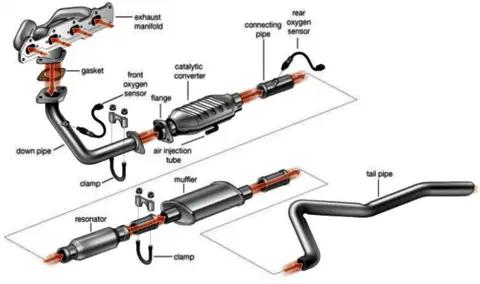
To further reduce the amount of unburnt hydrocarbons, catalytic converters also have what’s called an oxidation process as a component of the overall emissions reduction technology. This process uses a catalyst made of palladium or platinum to reduce the amount of CO (carbon monoxide) and HC (hydrocarbons) that exit your car’s exhaust system. The oxidative process converts these harmful emissions into simple carbon dioxide (CO2) and water.
These precious metals that are required to be used in converters to create the reactions are the reason that there has been a big problem with thieves stealing them right from under parked cars. Recyclers will pay good money for these devices so that they can harvest the precious metals, which can pay in the tens of thousands per troy ounce.
What can I do if I still fail emissions in California?
You can check out the special consumer assistance program for Californians with a car that fails to pass emissions. There are rebate options for cars that fail, up to $1,200 towards repair costs and either $1,000 or $1,500 towards the retirement of a vehicle that is cost prohibitive to fix.
Resources
Guaranteed To Pass full ingredients list.
Wikipedia – Catalytic Converter

Doug is our resident mechanic and automotive expert. With over 20 years of wrenching under his belt, he is our go-to for any question we have about additives and cars.

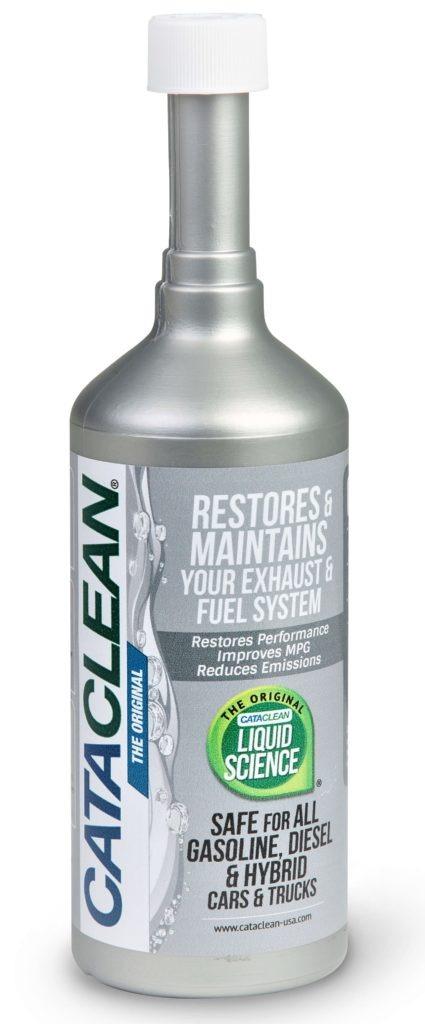


Hi Doug, My car has a 12.2 gallon gas tank is safe for me to put in all 16 Oz Dura Lube Catalytic cleaner or take out about 3.5 Oz.
Thx Scott
Hey Scott,
Using the full bottle will be no problem. Just be sure to fill up the tank after you pour it in. Good luck, hopefully it resolves your catalyst issues.
i have a w12 Bentley that i was told has a failing catalyst converter .the cost to replace $17,000 will these additive’s in any way damage the cars engine?
and do they really work?
claude
Hi Claude,
If the instructions are followed, they really cannot do harm to your engine. As for whether or not it will work in your car, only way to tell is to give it a try.